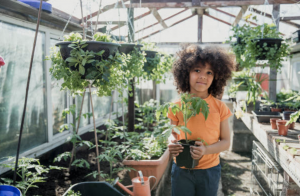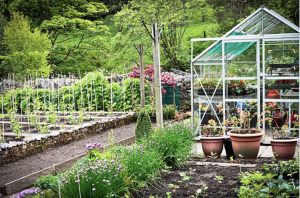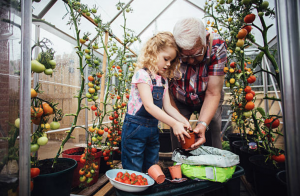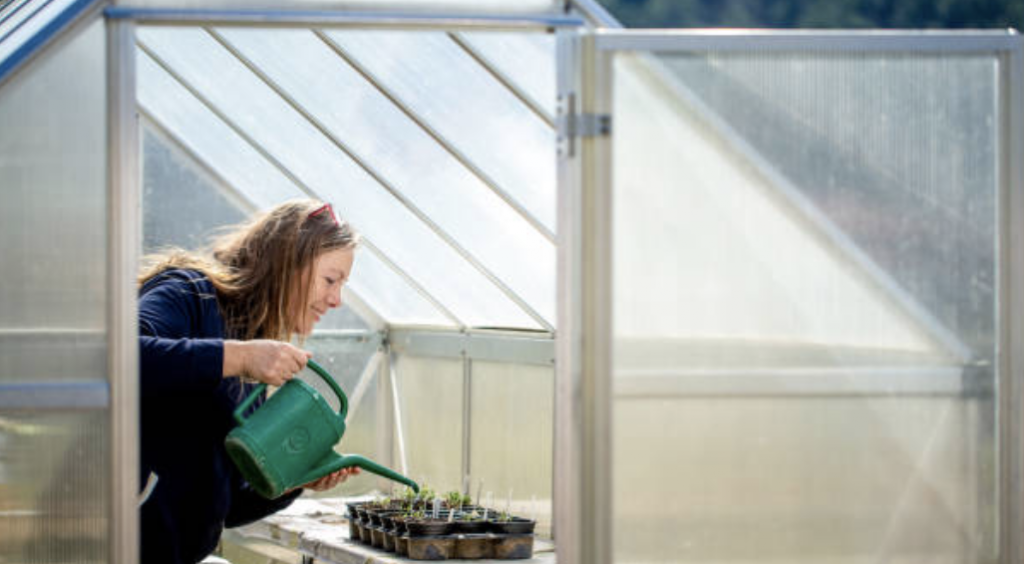Just like a dog isn’t just for Christmas, a greenhouse is not just for Spring and Summer. With a little bit of knowledge on what types of plants and crops to grow, and at what times, you can really get the most out of your greenhouse.
For this article, we are going to assume that you have a standard greenhouse and without a greenhouse heater one so as to make it as inclusive as possible.
We will give you planting and growing tips on a variety of different veggies, tips on what works best at different times of the year, and more. So, grab yourself a cuppa and get comfortable while we tell you how to grow in the greenhouse all year round.
Greenhouse growing from Winter to early Spring
If you think winter is a barren time and there’s nothing you can be doing in your greenhouse, then think again. There are actually quite a few vegetables that you sow at this time, although I would recommend germinating the seeds indoors first.

Some vegetables that are particularly resistant to frost, and therefore the best ones to sow in late winter to early spring. These include cauliflower, cabbage, broccoli, spinach, lettuce, and Brussel sprouts.
You can even get an early start on onions and leeks, but you might have to keep an eye on these and protect them with a garden fleece if extra protection from the cold is needed, and bubble wrap can also act as a great insulator in the coldest weeks of the year.
Onions, as well as turnips, radishes and spinach, are best sowed in early spring rather than late winter, and then they can be transplanted into the garden soil later when the temperatures rise.
Growing in a greenhouse in mid-Spring
Mid-Spring is a great time to fill your greenhouse with all those quick growing, tender vegetables and fruits. I’m talking about cucumbers, pumpkins, squashes, and melons, to name but a few.

These plants will thrive in the sunnier, warmer conditions and will be ready to transplant into your garden when summer rolls around.
The best place for crops like these are spots in the greenhouse that get the most sunlight, as this will give them the best chance of flourishing.
If you are intent on moving these tender plants from your greenhouse to garden soil in summer, you need to be extra careful that they are not exposed to frost or they simply won’t survive.
Articles you might like:
Grow vegetables easily
When to plant strawberries in the UK
This is a nice guide list too related.
Late Spring and early Summer growing
If you’ve taken our advice about sowing in winter, those crops should now be ready to move outdoors. Remember to keep an eye on these plants after they have been moved to the garden as they are still susceptible to frost, pests, disease, etc.
You should also harden off the plants that are moving outside for at least a week before transplanting to get them ready for the change or all that hard work might be in vain.

Now that you’ve cleared some space in the greenhouse, you can introduce some new crops such as tomatoes, as long as the weather and temperatures allow it. You could use a mini greenhouse to grow tomatoes all year round if you wanted.
Growing in mid to late Summer
Once you’ve harvested your summer fruits and veggies, you can get on with growing peppers, tomatoes, and eggplants.
Please remember though, that while these plants love the heat and sun, extreme temperatures can still have a negative effect on them, so make sure you monitor the temperature and ventilation inside the greenhouse.
Late summer is a great time to prepare for Christmas dinner by planting potatoes in containers.
Autumn crops for greenhouse growing
Good choices for planting in Autumn are baby carrots, broad beans, and peas. These can be kept in the greenhouse until early spring and then transferred outside once the ground becomes more manageable.
Planting turnips in early Autumn should allow you to harvest and enjoy them in winter, and the same goes for Kale.
If you have any herbs growing outside, such as chives, parsley, etc. You should move them into the greenhouse at this time to preserve them.
It is a common thing that greenhouse glass starts to look a bit dirty by Autumn and winter time, and this can affect the amount of sunlight getting in at a time when you need it most. Be sure to keep on top of cleaning the glazing in order to make the most of it. A good jet washer can make this job a lot easier.
Greenhouse related problems
Growing in greenhouses comes with its own set of problems that you need to be aware of. For a start there are pests such as greenhouse whitefly and glasshouse red spider mite that are particularly drawn to greenhouse conditions.

Keep an eye on your plants, remove any infected leaves and even full plants if you feel they need to be, and use an organic pesticide to deal with them if they become too problematic. If you get unlucky with blackfly then this article will help.
Diseases like powdery mildew, grey mould, and others are another issue you may have to contend with. The chance of these diseases affecting crops can increase due to the build up of the organisms in the soil, so be sure to replace the soil every few years to be on the safe side. Fungal infections like these thrive in humid environments too, and a poorly ventilated greenhouse will prove a great breeding ground for them.
And there you have it, our short guide to growing in a greenhouse all year round. As you probably gathered, the trick is, as usual, proper planning, and knowing which crops to plant in which seasons.
Hopefully, this article will help you achieve your greenhouse growing aims, and have you harvesting delicious home grown crops all year. If you are interested in more detailed descriptions of how to grow certain plants, please look through this site, as we have in depth ‘how to’ articles for many different plants, fruits and vegetables just waiting for you to read them.
